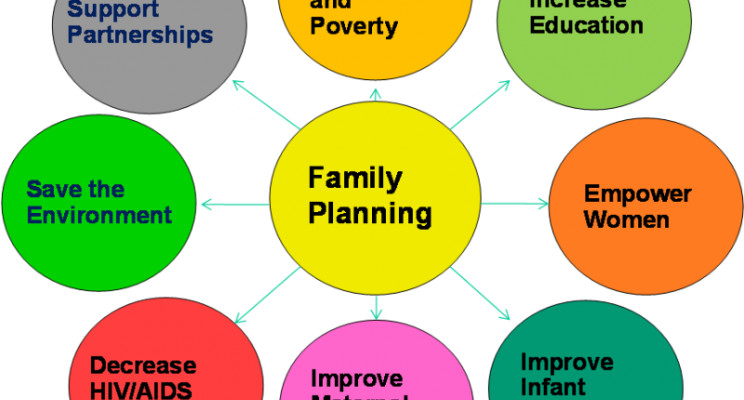
Benefits of Family Planning Worldwide.
- Family planning/Contraception:
Key facts: a. An estimated 225 million women in developing countries would like to delay or stop childbearing but are not using any method of contraception. b. Some family planning methods, such as condoms, help prevent the transmission of HIV and other sexually transmitted infections. c. Family planning/contraception reduces the need for abortion, especially unsafe abortion. d. Family planning reinforces people’s rights to determine the number and spacing of their children. e. By preventing unintended pregnancy, family planning /contraception prevents deaths of mothers and children.
Family planning allows people to attain their desired number of children and determine the spacing of pregnancies. It is achieved through the use of contraceptive methods and the treatment of infertility.
2. Benefits of family planning/contraception: Promotion of family planning – and ensuring access to preferred contraceptive methods for women and couples – is essential to securing the well-being and autonomy of women, while supporting the health and development of communities.
a. Preventing pregnancy-related health risks in women: A woman’s ability to choose if and when to become pregnant has a direct impact on her health and well-being. Family planning allows the spacing of pregnancies and can delay pregnancies in young women at increased risk of health problems and death from early childbearing. It prevents unintended pregnancies, including those of older women who face increased risks related to pregnancy. Family planning enables women who wish to limit the size of their families to do so. Evidence suggests that women who have more than 4 children are at increased risk of maternal mortality. By reducing rates of unintended pregnancies, family planning also reduces the need for unsafe abortion.
b. Reducing infant mortality: Family planning can prevent closely spaced and ill-timed pregnancies and births, which contribute to some of the world’s highest infant mortality rates. Infants of mothers who die as a result of giving birth also have a greater risk of death and poor health.
c. Helping to prevent HIV/AIDS: Family planning reduces the risk of unintended pregnancies among women living with HIV, resulting in fewer infected babies and orphans. In addition, male and female condoms provide dual protection against unintended pregnancies and against STIs including HIV.
d. Empowering people and enhancing education: Family planning enables people to make informed choices about their sexual and reproductive health. Family planning represents an opportunity for women to pursue additional education and participate in public life, including paid employment in non-family organisations. Additionally, having smaller families allows parents to invest more in each child. Children with fewer siblings tend to stay in school longer than those with many siblings.
e. Reducing adolescent pregnancies: Pregnant adolescents are more likely to have preterm or low birth-weight babies. Babies born to adolescents have higher rates of neonatal mortality. Many adolescent girls who become pregnant have to leave school. This has long-term implications for them as individuals, their families and communities.
f. Slowing population growth: Family planning is key to slowing unsustainable population growth and the resulting negative impacts on the economy, environment, and national and regional development efforts.
3. Who provides family planning/contraceptives? It is important that family planning is widely available and easily accessible through midwives and other trained health workers to anyone who is sexually active, including adolescents. Midwives are trained to provide (where authorised) locally available and culturally acceptable contraceptive methods. Other trained health workers, for example, community health workers, also provide counselling and some family planning methods, for example, pills and condoms. For methods such as sterilisation, women and men need to be referred to a clinician.
4. Contraceptive use: Contraceptive use has increased in many parts of the world, especially in Asia and Latin America, but continues to be low in sub-Saharan Africa. Globally, use of modern contraception has risen slightly, from 54% in 1990 to 57.4% in 2015. Regionally, the proportion of women aged 15–49 reporting use of a modern contraceptive method has risen minimally or plateaued between 2008 and 2015. In Africa it went from 23.6% to 28.5%, in Asia it has risen slightly from 60.9% to 61.8%, and in Latin America and the Caribbean, it has remained stable at 66.7%. Use of contraception by men makes up a relatively small subset of the above prevalence rates. The modern contraceptive methods for men are limited to male condoms and sterilisation (vasectomy).
5. The Global unmet need for contraception: An estimated 225 million women in developing countries would like to delay or stop childbearing but are not using any method of contraception. Reasons for this include a. Limited choice of methods; b. Limited access to contraception, particularly among young people, poorer segments of populations, or unmarried people; c. Fear or experience of side-effects; d. Cultural or religious opposition; e. Poor quality of available services; f. Users and providers bias; g. Gender-based barriers.
The unmet need for contraception remains too high. This inequity is fuelled by both a growing population and a shortage of family planning services. In Africa, 24.2% of women of reproductive age have an unmet need for modern contraception. In Asia, and Latin America and the Caribbean – regions with relatively high contraceptive prevalence – the levels of unmet need are 10.2 % and 10.7%, respectively (Trends in Contraception Worldwide 2015, UNDESA).
6. WHO response: WHO is working to promote family planning by producing evidence-based guidelines on safety and service delivery of contraceptive methods, developing quality standards and providing pre-qualification of contraceptive commodities, and helping countries introduce, adapt and implement these tools to meet their needs.
Courtesy of: WHO Media Centre, http://www.who.int/mediacentre/factsheets/fs351/en/